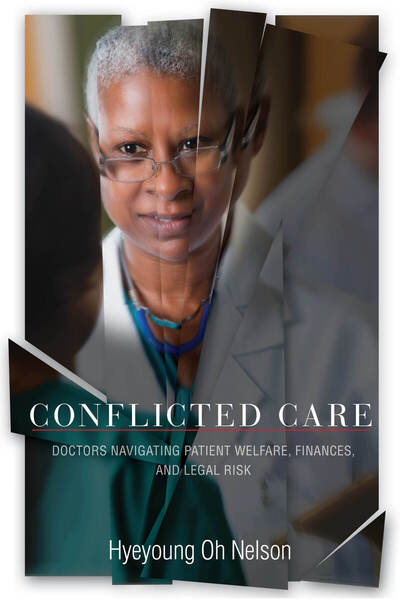Reviewed Book
Conflicted Care: Doctors Navigating Patient Welfare, Finances, and Legal Risk By Hyeyoung Oh Nelson, Stanford, CA: Stanford University Press. 2022. 142 pp.

Mara H. Buchbinder
University of North Carolina at Chapel Hill
The US medical system was in crisis even before the COVID-19 pandemic, but the past 3 years have brought into sharp relief just how precarious and fundamentally broken it is. In this timely, engaging ethnography of US medicine, Hyeyoung Oh Nelson explores how physicians navigate the conflicting demands of commodified healthcare: provide good care and support the hospital’s bottom line. Drawing on 26 months of ethnographic fieldwork conducted in an internal medicine service of an elite academic medical center she calls Pacific Medical Center, Nelson, a medical sociologist, shows how competing institutional logics structure clinical practice and decision-making. Nelson suggests that attention to these competing logics—health, market, legal, research, and training—can help to explain some of the most intractable problems facing contemporary healthcare.
Nelson’s central argument revolves around the concept of moral polysemy, which she defines as situational variation in moral decision-making. Moral polysemy enables individuals to align their actions with a single underlying goal or objective while also pursuing other distinct yet potentially conflicting goals. This approach acknowledges that preserving patient welfare is a consistent goal in hospital medicine, but it does not always lead to consistent decisions. For example, the health logic and training logic compete when relatively inexperienced resident physicians care for hospitalized patients. When physicians justify their decisions using these competing logics, they engage in moral polysemy.
A central premise of Conflicted Care is that learning to navigate these institutional logics constitutes a “hidden curriculum” of doctoring that is not explicitly taught in medical school. Here, the book builds on a foundational body of anthropological and sociological research describing the professional socialization of physicians (e.g., work by Renee Fox, Howard Becker, Charles Bosk, Mary-Jo Delvecchio Good and Byron Good, and others). Nelson updates this work with attention to contemporary examples that have received less attention, including electronic medical record documentation and interspecialty care.
Many of the challenges that Nelson describes—readmission following hospital discharge, unnecessary treatment, defensive medicine—are well-documented in the medical literature. What Nelson adds, however, is a fine-grained understanding of how and why they persist despite multiple attempts to address them. Her ethnographic explanations reveal how professional factors contribute to the intractability of these problems in ways that belie straightforward policy fixes. For example, she partially attributes the problem of unnecessary treatment to interspecialty care and distributed responsibility for decision-making. Similarly, the clinical literature casts electronic medical record documentation as a leading cause of clinician burnout yet sheds little light on how it affects patient care. Nelson shows how the electronic medical record creates obstacles to patient care, including denial of coverage by insurance companies, and illustrates the workarounds employed to address such obstacles, such as interjecting specific wording.
While Conflicting Care substantially advances the clinical literature, its contributions to the social sciences might have been pushed further. Throughout the book, the concept of moral polysemy is somewhat underdeveloped. It is not clear to me that all the decisions she considers are moral decisions—and if so, what makes them moral. Some seem to be governed purely by an economic logic. For example, when a patient is transferred from Pacific Medical Center to a distant community hospital (that the patient hated) because the patient’s insurance would not cover a long-term stay at Pacific, the conflicts between the market and health logics are evident. Yet less clear to me is whether the team claims that this decision lies in the patient’s best interest (a putative component of moral decision-making). Use of the anthropological concept of moral economy might have been useful for further teasing out the entanglements of market and health logics.
Conflicted Care’s numerous strengths far outweigh this limitation. It is highly accessible, short, and absorbing, making it an ideal text for teaching. It would be particularly useful for introductory level courses in medical anthropology, medical sociology, and public health for teaching about the lived experiences of US health policy. I can imagine using it alongside course materials on the hidden curriculum and structural competence. The methodological appendix that appears that the end of the book is particularly valuable in offering not only a primer on research design and methods, but also an intellectual genealogy of the project, including roadblocks and detours. Here, she explains how her research questions shifted once in the field from end-of-life decision-making to financial and bureaucratic constraints in care. This section of the book would be very helpful for graduate students, particularly those navigating access to clinical settings.
Conflicted Care concludes with recommendations for policy improvement, which include teaching medical students about the market logic, strengthening networks that connect hospitals to outpatient care, and investing in national campaigns to minimize unnecessary treatment. Insofar as medical anthropologists often shy away from offering practical recommendations, I found this discussion refreshing. My university department, which teaches a unique three-semester sequence in social medicine and the medical humanities to all preclinical medical students, already has a curriculum in medical finance along the lines that Nelson envisions; it is uniformly embraced by our students. Nelson’s suggestions align well with initiatives currently underway by medical anthropologists working in schools of medicine to incorporate structural competency and related concepts into medical school curricula. Anthropologists engaged in such efforts would find much to admire in this thoughtful, well-written book.